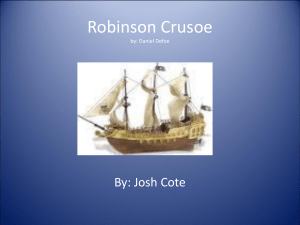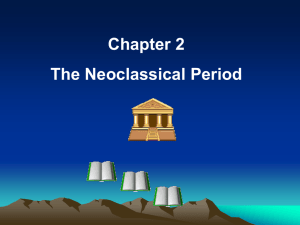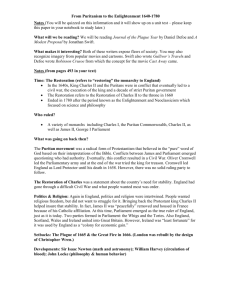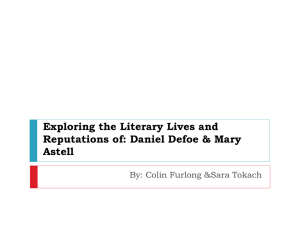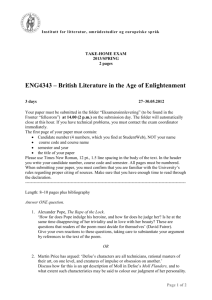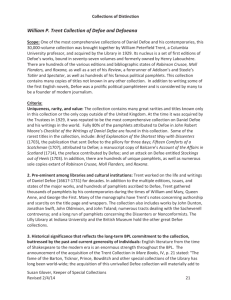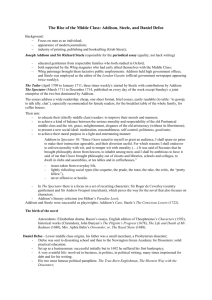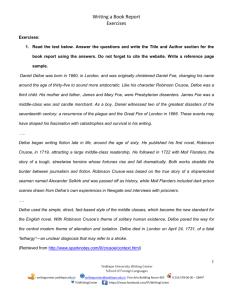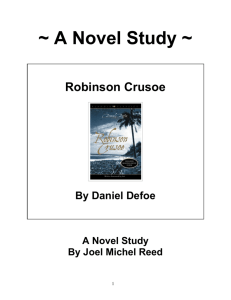Defoe and “the Footprints of Man”
advertisement
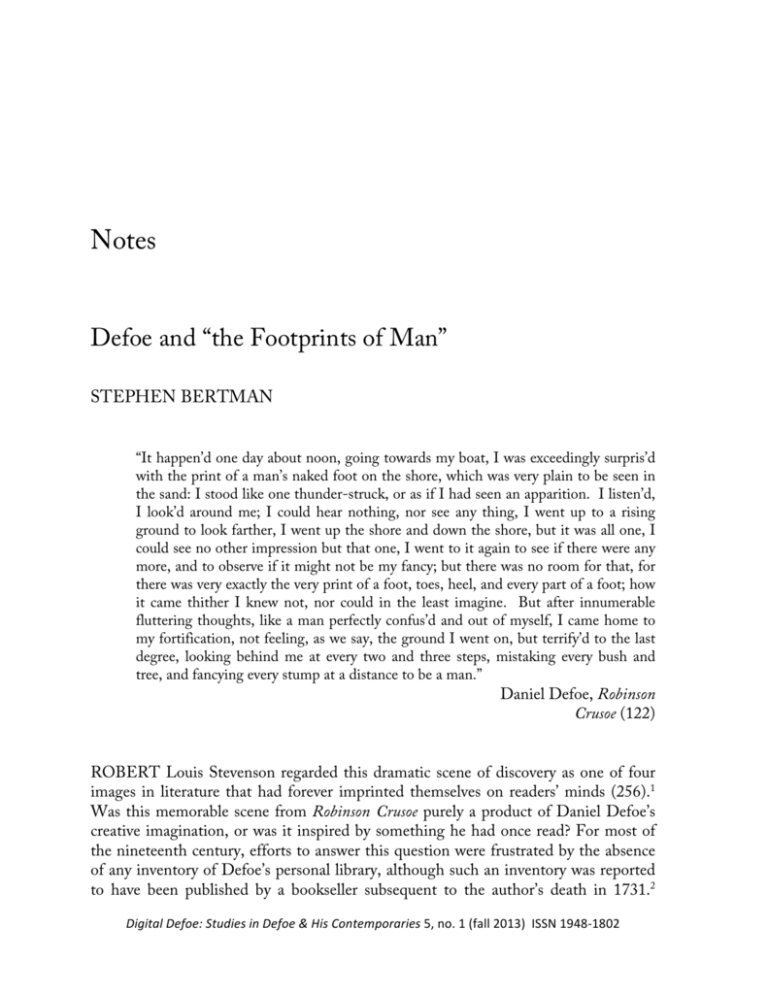
Notes Defoe and “the Footprints of Man” STEPHEN BERTMAN “It happen’d one day about noon, going towards my boat, I was exceedingly surpris’d with the print of a man’s naked foot on the shore, which was very plain to be seen in the sand: I stood like one thunder-struck, or as if I had seen an apparition. I listen’d, I look’d around me; I could hear nothing, nor see any thing, I went up to a rising ground to look farther, I went up the shore and down the shore, but it was all one, I could see no other impression but that one, I went to it again to see if there were any more, and to observe if it might not be my fancy; but there was no room for that, for there was very exactly the very print of a foot, toes, heel, and every part of a foot; how it came thither I knew not, nor could in the least imagine. But after innumerable fluttering thoughts, like a man perfectly confus’d and out of myself, I came home to my fortification, not feeling, as we say, the ground I went on, but terrify’d to the last degree, looking behind me at every two and three steps, mistaking every bush and tree, and fancying every stump at a distance to be a man.” Daniel Defoe, Robinson Crusoe (122) ROBERT Louis Stevenson regarded this dramatic scene of discovery as one of four images in literature that had forever imprinted themselves on readers’ minds (256).1 Was this memorable scene from Robinson Crusoe purely a product of Daniel Defoe’s creative imagination, or was it inspired by something he had once read? For most of the nineteenth century, efforts to answer this question were frustrated by the absence of any inventory of Defoe’s personal library, although such an inventory was reported to have been published by a bookseller subsequent to the author’s death in 1731.2 Digital Defoe: Studies in Defoe & His Contemporaries 5, no. 1 (fall 2013) ISSN 1948-­‐1802 Then, over a century and a half later in 1895, the bibliographical problem was seemingly solved by George Atherton Aitken, who discovered lying on a shelf in the British Museum the long-sought auction catalogue listing the books Defoe had once owned (Librorum ex Bibliothecis).3 However, there were two problems with this catalogue. First, the bookseller, Olive Payne, had combined the items from Defoe’s collection with those belonging to the Rev. Philips Farewell, Fellow of Trinity College, Cambridge, without indicating which of the two individuals had owned which books. A careful review of Farewell’s academic interests, financial resources, and age at the time of his death “points to the conclusion that with the exception of possibly a hundred titles, these books were Defoe’s” (Kropf 133), but which those “hundred titles” were is uncertain. Second, missing from the catalogue were any books Defoe might have given away prior to his death—perhaps to his children or to his son-in-law, Henry Baker, a man of literary and scientific interests4—or any books Defoe might have sold to alleviate the burden of debt that haunted him as he neared the end of his life. In 1922, after surveying the works listed by Aitken, Arthur Wellesley Secord proposed that the memorable “footprints” scene in Robinson Crusoe might have been inspired by one of three travel books Defoe could have owned or had access to: Robert Knox’s An Historical Relation of Ceylon (1681), William Dampier’s two-volume A New Voyage Round the World (1697 and 1699), and, with less probability, Hendrik Smeeks’ Dutch work, A Description of the Mighty Kingdom of Krinke Kesmes (1708) (Secord 107, 100–101).5 Significantly, of these three works only Knox’s was listed in the Olive Payne catalogue. While all three works speak of footprints on islands, it is noteworthy that none of their discovery scenes exhibit the dramatic intensity of the one in Robinson Crusoe, a scene characterized by the narrator’s shock at finding totally unexpected evidence of another human being’s presence on his island. To convey this mood of excitement, Defoe had employed such words as “surprised,” “thunderstruck,” “apparition,” “confused,” and “terrified.” Dampier, for his part, told of sighting footprints over a week old that at first had seemed troubling to him because they might have been left by potentially hostile Spaniards; however, he soon dismissed the likelihood of such a threat on logical grounds. 6 Knox and Smeeks, for their part, did not describe the footprints of strangers at all. Knox noted how he and a companion had left their own footprints in the soft ground while deliberately walking backward to mislead possible pursuers,7 while Smeeks reported how a search party, and later a lost boy, had spotted the footprints of their own comrades.8 Indeed, all of these scenes referred to the footprints of fellow Europeans, not to those of a “savage.” As early as 1908, another work had been proposed as a possible influence on Robinson Crusoe: the twelfth century philosophical romance, The History of Hayy Ibn Yaqzâm, by the Moorish author, Abu Bakr Ibn Tufail. 9 The History tells of an untaught feral child who achieves intellectual and spiritual enlightenment while alone 131 on a desolate island. The story was eventually translated by Edward Pococke the Younger into Latin in 1671 as Philosophus Autodidactus and into English by Simon Ockley—and thus was accessible to Defoe—in 1708,10 and may well have influenced John Locke’s An Essay Concerning Human Understanding (1690), given that Locke had been a student of Pococke.11 However, although the romance mentions footprints, it is not their presence but rather their absence that is described. In addition, the narrative lacks any element of surprise.12 Furthermore, the History is not listed in the Olive Payne catalogue. As it turns out, in depending upon Aitken’s published list of Defoe’s books for his research, Arthur Secord had unknowingly used only an abridgement. 13 A comparison of the Aitken article with the actual Olive Payne catalogue reveals that Aitken had included only 296 items out of a total of 1,754 originally listed. Omitted by both Aitken and Secord is a volume that deserves our special attention: item #1035, a 1683 edition of a work called The Apophthegmes of the Ancients. The Apophthegmes of the Ancients is a 335-page compendium in English of biographical anecdotes, or “apophthegmes,” drawn from the works of various Classical authors including Plutarch and Diogenes Laertius, and modeled on an earlier anthology by Erasmus that was itself indebted to Plutarch. In fact, when Defoe was about 22 years old, he personally compiled a similar collection of anecdotes, largely Classical, which he entitled Historicall Collections, or, Memoires of Passages & Stories from Severall Authors.14 Drawing the stories from his youthful readings, he sent this collection in handwritten form as a gift to his future wife, Mary.15 Purchased for two pounds from an English bookseller in 1951, the unattributed holograph lay in the University of California’s William Andrews Clark Memorial Library for thirty more years until its authorship was determined by Maximillian E. Novak, who recognized Defoe’s elegant handwriting and identified the names “Bellmour” and “Clarinda” in the dedication as sobriquets for Defoe and his bride-to-be.16 Included in Defoe’s copy of the Apophthegmes of the Ancients was an anecdote about a Greek philosopher and friend of Socrates named Aristippus (fl. ca. 435−386 BCE), who was shipwrecked on a seemingly deserted island: “Having been cast ashore by a Tempest on a desart Coast, and spying some Mathematical Schemes upon the Land: ‘Courage,’ said he, ‘I see some marks of men here.’ Note, the Barbarians, whom he treats as beasts, were not capable of those Sciences” (Apophthegmes 222). Like Robinson Crusoe, the Greek castaway Aristippus made an astonishing discovery on a deserted beach, a detailed pattern in the sand (recall the specificity of Crusoe’s words: “the very print of a foot, toes, heel, and every part of a foot”) that disclosed that another human being was living on an island he had previously assumed was uninhabited.17 In addition, the ancient Greek tale also incorporates a theme very much a part of Defoe’s novel but not at all evident in the accounts by Knox, Dampier, or Smeeks: the contrast between civilization and savagery. As the editor of the Apophthegmes of the Ancients makes clear in his commentary, beast-like barbarians were 132 incapable of such sciences as geometry, dependent as such sciences are upon the cultivation of reason, a faculty celebrated in Robinson Crusoe.18 Notably absent from the episode, however, is any reference to an actual footprint like the one described in Defoe’s novel. The Apophthegmes of the Ancients was not, however, Defoe’s earliest introduction to the story of Aristippus’ shipwreck. Prior to composing his own Historicall Collections in 1682, Defoe had encountered another set of apophthegmes, or anecdotes: the Apophthegmes of Erasmus (1542), which had been translated into English by Nicholas Udall in 1564. Defoe’s familiarity with this work is attested by a marginal note found in his Historicall Collections manuscript, a note in which the young Defoe specifically refers to having read Udall’s translation of Erasmus’ work.19 Defoe, in fact, included in his Historicall Collections two anecdotes about Aristippus taken from Erasmus’ work, both concerning the philosopher’s sojourn in ancient Syracuse.20 Erasmus had devoted a major portion of his Apophthegmes to the career of Aristippus. After telling of a storm the philosopher had encountered on a voyage to Corinth (“Aristippus,” sect. 17), he went on (sect. 61) to describe a shipwreck Aristippus had survived on the coast of Rhodes: “At a certain season, sailing in ther companie of three or fower of his own countree men or neighbours, he was cast on land by shipwracke. And when he had on the sandes, espied the prente of mathematicall figures of Geometrie drawen in the sande: All is wel maisters (quothy he) I haue espied the steppes and signes of men.”21 As the Apophthegmes of Erasmus indicates in a marginal note (sect. 61), Erasmus had borrowed the story from the ancient Roman architectural historian Vitruvius. According to Vitruvius’ De Architectura: “When the Socratic philosopher Aristippus was shipwrecked on the coast of Rhodes and noticed geometric diagrams drawn on the beach, he is said to have shouted to his companions, ‘Take heart, my friends, for I see the footprints of man (“hominum enim vestigia video”)!’” (Vitruvius 6.1). 22 In both the original Vitruvian version of the story and in its retelling by Erasmus, the geometrical diagrams—called “the footprints of man” by Vitruvius—stood as a metaphor for civilization. When the young Defoe read the Apophthegmes of Erasmus, the 133 dramatic “footprint” metaphor may well have fallen like a seed into his fertile imagination, where it would lay until it germinated some thirty-five years later in his conception of Robinson Crusoe’s discovery scene. Processed through Defoe’s mind, however, the symbolism of the Classical tale became inverted: footprints, actual rather than metaphorical, came to foreshadow not the presence of civilized men but of a savage, while joy was replaced by fear. Indeed, eighteen years prior to Crusoe’s publication, the character of Aristippus made an early appearance, not as a castaway but as a pleasure-loving tippler, in Defoe’s long poem, The True-Born Englishman: A Satyr.23 That Defoe knew of the writer Vitruvius is demonstrated by the fact that he once praised Lord Burlington as a modern Vitruvius for his design of Tottenham Park, “built by our Modern Vitruvius, the Earl of Burlington, who gave to English Architecture the elegance and politeness of Italian taste” (Defoe, Tour, qtd. in Harris 16n5). Vitruvius’ name was, in fact, renowned in Defoe’s day because of the Palladioinspired revival of the Classical style of architecture in Britain under the leadership of Inigo Jones (1573−1652), whose designs were celebrated in Colen Campbell’s elaborately illustrated work, Vitruvius Britannicus; or, The British Architect (1715−1725). Campbell’s first volume had appeared just four years before the publication of Robinson Crusoe, and the second volume appeared in the very same year as the novel. Indeed, Robert Harley, first Earl of Oxford and Defoe’s patron, was one of many wealthy Englishmen who with their subscriptions underwrote the publication of Campbell’s work (Campbell 1: 9). Defoe’s interest in architecture in general is manifest in his A Tour thro’ the Whole Island of Great Britain (1724−1727) and is attested to by the fact that the Olive Payne catalogue includes over a dozen books on the topic of architecture. Had Defoe somehow encountered the story of Aristippus in its Vitruvian version that included the “footprints of man” metaphor, in what type of edition would he have read it? A complete English translation of De Architectura, including the crucial sixth book that opens with the anecdote, did not appear until 1791, long after Defoe’s death.24 This English edition had been preceded by a series of Italian translations in 1556, 1567, and 1629, which were in turn followed by a French translation in 1673. Therefore, Defoe would have had to have read Vitruvius in Italian or French, had he access to those editions, or in the original Latin, which would certainly have been available to him. Assuming he had the inclination, was he capable of reading and understanding these languages? Defoe’s own testimony is that he knew all three languages, though he detested the display of Latin as a contemptible aristocratic conceit. 25 Yet his having read Vitruvius is mere speculation since no copy of Vitruvius’ work is listed in the Olive Payne inventory of Defoe’s library. Not in the Olive Payne catalogue is another intriguing book that deserves our attention. It is the very first translation into English of the surviving books of Euclid’s Elements, the 1703 Oxford edition by the great Scottish astronomer and 134 mathematician, David Gregory. Gracing the opening pages of this volume is a fullpage engraving by the Dutch artist, Michael Burghers, depicting the Aristippus story (Figure 1). In the picture, with their foundering ship sinking in the background, four survivors gather around Aristippus as he points to the drawings in the sand. The caption in Latin reads: “When the Socratic philosopher Aristippus was shipwrecked on the coast of Rhodes and noticed geometric diagrams drawn on the beach, he is said to have shouted to his companions, ‘Take heart, my friends, for I see the footprints of man.’” The source of the quotation—Vitruvius, Book 6, Chapter 1—is printed immediately beneath the engraving.26 Had Defoe, who prided himself at having studied Euclid’s Elements in school,27 later encountered this edition, he may have become inspired by its pictorial depiction of shipwreck and salvation. That Defoe was intrigued by mathematics and geometry in particular is clearly demonstrated by the Olive Payne catalogue of his library, which lists twenty-nine books on mathematics, including seven on geometry.28 And, as we have seen elsewhere, Defoe held the science of mathematics in high regard.29 To summarize, in conceptualizing the discovery scene in his novel, Defoe may have been influenced first by his youthful encounter with Udall’s English translation of the Apophthegmes of Erasmus; by his subsequent acquisition of a copy of the Apophthegmes of the Ancients; by possibly having read Vitruvius’ original version of the Aristippus story; and perhaps, just perhaps, by having seen Burghers’ engraving. 2019 will mark the three hundredth anniversary of the publication of Defoe’s Robinson Crusoe. In the almost three centuries since it appeared, wave after wave has washed over the sands of Crusoe’s beach, obliterating that memorable footprint and obscuring its literary inspiration. Despite this, however, the most important footprints still remain: those of the author who once boldly trod those shores in his vivid imagination and invited us, and all future generations, to share in the grand adventure. University of Windsor NOTES 1 Stevenson describes the four images thus: “Crusoe recoiling from the footprint, Achilles shouting over against the Trojans, Ulysses bending the great bow, Christian [in Bunyan’s The Pilgrim’s Progress] running with his fingers in his ears” (256). 2 His biographer William Lee writes, “About six months after his death his Library, or the greater part of it, was sold to Mr. Olive Payne, the bookseller in Round Court, in the Strand, who published a Catalogue of his Books, and those of the Rev. Philip Farewell, D.D. I have searched in vain for this Catalogue, and fear that a copy does not exist.* *See a long advertisement of the Catalogue in The Daily Advertiser, 13 Nov. 1731” (1: 470). 135 3 See also Helmut Heidenreich, ed., The Libraries of Daniel Defoe and Philips Farewell: Olive Payne’s Sales Catalogue, 1731, which is particularly valuable for its comprehensive introduction and its detailed listings of book subjects. For a general account of the catalogue and the history of its discovery see George A. Aitken, “Defoe’s Library,” 706– 707; Tim Severin, In Search of Robinson Crusoe, 181–83; and Heidenreich’s introduction to The Libraries of Daniel Defoe and Philips Farewell, vii–xxxix. 4 This suggestion was first made by Aitken in “Defoe’s Library,” 706. In Daniel Defoe, Master of Fictions: His Life and Ideas, Maximillian E. Novak notes that “some of the books went to Henry and Sophia Baker and show up in the catalogue of Henry Baker’s library (704). The contents of Henry Baker’s library were sold at auction on February 10, 1772; see the List of Catalogues of English Book Sales, 1676–1900, Now in the British Museum, ed. Harold Mattingly, I.A.K. Burnett, and Alfred W. Pollard (77). However, the auction catalogue does not indicate which of the books included in the sale had belonged to Defoe. I am grateful to Qona Wright of The British Library’s Rare Books and Music Reference Service for locating and providing me with a facsimile of the actual catalogue: A Catalogue of the Library with the Prints and Books of Prints of Henry Baker, Esq. 5 Secord regarded the influence of Knox and Dampier as far more certain than that of Smeeks (100–107), a view vigorously challenged by David Fausett in The Strange Surprizing Sources of Robinson Crusoe, 175–194. For a survey of the various travel books Defoe may have read together with a discussion of their possible influence on his novel see Pat Rogers, Robinson Crusoe, 27–34. 6 “We were no sooner at Anchor [at the Isles of Pines off the west coast of Cuba], but five of us went ashore, leaving only the Cook and Cabbin-Boy aboard: We had but two bad Fowling-Pieces in the Ship; those we took with us, with a Design to kill Beef and Hog. We went into the Lagune, where we found Water enough for our Canoa, and in some Places not much to spare; when we were almost over it, we saw eight or ten Bulls and Cows feeding on the Shore close by the Sea. This gave us great Hopes of good Success. We therefore rowed away aside of the Cattle, and landed on a sandy Bay, about half a Mile from them: there we saw much Footing of Men and Boys; the Impressions seemed to be about eight or ten days old, we supposed them to be the Track of Spanish Hunters. This troubled us a little, but it being now their Christmas, we concluded that they were gone over to Cuba to keep it there, so we went after our Game…” (Dampier 2: 137 [pt. 2, ch. 1]). 7 “Being come at the River, we left the Road, and struck into the woods by the River side. We were exceeding careful not to tread on the Sand or soft Ground, lest our footsteps should be seen; and where it could not be avoided, we went backwards, so that by the print of our feet, it seemed as if we had gone the contrary way. We were now gotten a good way into the Wood; when it grew dark and began to Rain, so that we thought it best to pitch 136 our Tents, and get Wood for Firing before it was all wet, and too dark to find it. Which we did, and kindled a fire” (Knox 261 [pt. 4, ch. 10]). 8 “Having searched on land one day in vain, on the next we sailed along the coast for some hours, firing a cannon-shot every bell. We set men on shore to seek again, who did not find anyone, although they saw some tracks of bare feet in the sand” (Hubbard 2); “I had plenty to eat, as I have said, and I walked towards the sea in the hope that our ship or people were still there, but found no one. While thus walking along the strand, I looked back continually, so that the mountain should not get out of my sight. On the way I thought I saw a mast behind a dune, with its top sticking out above. I though also that I saw footprints, but these again disappeared” (Hubbard 16–17). 9 On this possible influence, see A.S. Fulton, introduction to Ockley’s translation of The History of Hayy Ibn Yaqzan; Lenn Evan Goodman, introduction to Hayy Ibn Yaqzan: A Philosophical Tale; A.T.S. Goodrick, “Robinson Crusoe, Imposter,” 672−85; Antonio Pastor, The Idea of Robinson Crusoe, 1: 305−66; and Nawal Muhammad Hassan, Hayy bin Yaqzan and Robinson Crusoe: A Study of an Early Arabic Impact on English Literature. 10 A 1711 edition of Ockley’s Life of Hai Ebn Yokdhan was found in the library of Defoe’s son-in-law, Henry Baker, F.R.S., following his death (see item #209 in the 1772 Baker auction catalogue.) It is conceivable that Baker may have inherited this volume from his father-in-law’s collection, which at the time of Defoe’s death included another Ockley work, vol. 2 of The History of the Saracens (1718), listed as item #1012 in the Olive Payne catalogue. 11 See Gül A. Russell, “The Impact of the Philosophus Autodidactus: Pockocke, John Locke and the Society of Friends,” 224−65. 12 “Hayy Ibn Yaqzân, in the mean time, was wholly immers’d in his sublime Extasies, and never stirred out of his Cave but once a Week, to take such Provision as first came to hand. So that Asâl did not light upon him at first, but walk’d round the Island, and explor’d its various Parts, without seeing any Man, or so much as the Footsteps of any: Upon which account his Joy was increas’d, and his Mind exceedingly pleas’d, in regard to his compassing that which he had propos’d to himself, namely, to lead the most retired Life that was possible.” “At last it happen’d, one time that Hayy Ibn Yaqzân coming out to look for Provision in the same place whither Asâl was retired, they spy’d one another” (Ibn Tufayl, The History 159−60 (sect. 103−104). 13 On this point see Heidenreich, introduction to The Libraries of Daniel Defoe and Philips Farewell, ix−x. 137 14 In his A Checklist of the Writings of Daniel Defoe, John Robert Moore cites this as the second earliest known work attributable to Defoe, the first being a 1681 holograph entitled Meditac[i]ons, now in the Huntington Library. 15 This rare manuscript survives and is preserved in the collection of the William Andrews Clark Memorial Library, University of California, Los Angeles (MS.1951.009). The importance of the manuscript was first noted and discussed by Maximillian E. Novak in his Realism, Myth, and History in Defoe’s Fiction, 18−21, as well as in his Daniel Defoe: Master of Fictions, 38−39 and passim. (I am indebted to Scott Jacobs of the Clark Library for providing me with a photographic copy of the manuscript.) 16 See Maximillian E. Novak, “Lost Defoe Manuscript Discovered,” 1−3. 17 The underlying similarity between the stories of Aristippus and Robinson Crusoe was observed as early as 1862 (Goodeve, The Law of Evidence 28) and as recently as 2011 (McGrath 15), but in no case was one story viewed as the possible inspiration for the other. The similar settings of the two stories have also suggested the title for an anthology of literary essays edited by Zbigniew Białas, Aristippus Meets Crusoe: Rethinking the Beach Encounter. Dr. Białas graciously sent me a copy of his work. 18 “As reason is the substance and original of the mathematicks, so by stating and squaring every thing by reason, and by making the most rational judgment of things, every man may be in time master of every mechanick art” (Defoe, Robinson Crusoe 55). 19 See Novak, Realism, Myth, and History in Defoe’s Fiction, 19−20. “Nicho: Udall” inscribed in Defoe’s handwriting can be seen in the left-hand margin of page 71 in the PDF version of manuscript available from the UCLA’s Clark Library. 20 Compare Historicall Collections, 29 (UCLA Clark Library PDF) with Udall, “Aristippus,” sect. 1; and Historicall Collections, 55 (UCLA Clark Library PDF) with Udall, “Aristippus, sect. 8. 21 While Udall speaks here of both footprints (“steppes”) and diagrams (“signes”), Erasmus’ original Latin text had used only the phrase “hominum vestigia adspicio” (“I have espied the footprints of man”). (I am grateful to my colleague, Dr. Charles Fantazzi, for supplying me with Erasmus’ original wording.) 22 This episode opens the sixth volume of Vitruvius’ ten-volume treatise. 23 Nor do the Poor alone their Liquor prize The Sages join in this great Sacrifice. The Learned Men who study Aristotle, Correct him with an Explanation Bottle, 138 Praise Epicurus rather than Lysander, And *Aristippus more than Alexander. ______________________________ *The Drunkards Name for Canary Defoe inserted the asterisk and footnote above into his text to alert the reader to that fact that Aristippus’ name was being used as a pun, for it was not only the name of a Greek philosopher, as we have already seen, but in Defoe’s time it had become a name for “canary,” a type of fortified wine like sherry. The early seventeenth century English playwright Thomas Randolph had, in fact, constructed an entire play around this pun in his first comedy entitled Aristippus, or the Jovial Philosopher, which was performed as a student play in Cambridge in the 1620’s and published in 1630. See http://petworthplays.wordpress.com/2012/07/29/aristippus-or-the-jovial-philosopher. 24 The two-volume 1791 edition of The Architecture of M. Vitruvius Pollio was translated by William Newton. An earlier translation by Newton including only the first five books of Vitruvius’ treatise had appeared in 1771, based upon an abridged French translation by Claude Perrault (1673; corr., 1684), later translated into English by A. Boyer (1692). Newton’s “Preface” (iii−v) gives an informative chronological account of the translations that had preceded his own. 25 “He was able to read the Greek classics, and had not only mastered the most difficult Latin authors, but himself produced Latin compositions for the press; he translated and spoke Spanish, Italian, and French, the latter fluently, and had some knowledge of Dutch” (Lee 10). “I have been in my Time pretty well Master of five Languages, and have not lost them yet, tho’ I write no Bill over my Door, nor set Latin Quotations on the Front of the Review” (Defoe’s Review 7: 114 [December 16, 1710], 455). Regarding his rival, John Tutchin, Defoe wrote: “As to my little Learning, and his great Capacity, I fairly Challeng’d him, in a letter I sent him Yesterday, and which I now Renew, ‘That I’ll take any Latin Author he shall Name, and with it one French, and one Italian, and I’ll Translate them into English, and after that Re-translate them Cross-wise, the English into French, the French into Italian, and the Italian into Latin; and this I challenge him to perform with him, who does it soonest and best for ₤20 each Book; and by this he shall have an Opportunity to show the World, how much De Foe the Hosier, is inferior in Learning, to Mr. Tutchin the gentleman” (Defoe’s Review 2: 38 [May 31, 1705], 150). 26 For a reproduction of the engraving including its caption, see the frontispiece of Sir Thomas Heath’s Archimedes. For an online image without the caption, see www.mlahanas.de/Greeks/Bios/Aristippus.html. 27 Defoe mentions this in the Review 7: 114 (December 16, 1770): 455. 139 28 29 Archimedis Opera together with two treatises on cylinders and cones (item #267), Geometrie Practique [sic] de l’Ingenieur (item #507), Barrow’s Archimedes (item #595), Le Elemens [sic] d’Euclid by Dechalles (item #1283), and La Geometrie by Crousaz (item #1300). See note 18 above. WORKS CITED Aitken, George A. “Defoe’s Library.” The Athenaeum 3527 (June 1, 1895): 706−707. Print. The Architecture of M. Vitruvius Pollio. Trans. and Intro. William Newton. 2 vols. London, 1791. Print. A Catalogue of the Library with the Prints and Books of Prints of Henry Baker, Esq. London: Sotheby, February 10, 1772. Print. [BL Mic. B740/1/5; S.C. Sotheby, Lugt number 1994]. Białas, Zbigniew, ed. Aristippus Meets Crusoe: Rethinking the Beach Encounter. Katowice, Poland: Wydawnichwo Uniwersytetu Śląskiego [University of Silesia Press], 1999. Print. Bulteel, John. ed. The Apophthegmes of the Ancients; Taken out of Plutarch, Diogenes Laertius, Elian, Atheneus, Stobeus, Macrobius, and others; Collected into one Volume for the Benefit and Pleasure of the Ingenious. London, 1683. Google Books. Web. 30 May 2013. Campbell, Colen. Vitruvius Britannicus; or, The British architect, containing the plans, elevations, and sections of the regular buildings, both publick and private in Great Britain, with variety of new designs. 1715−1725. 3 vols. New York: Benjamin Blom, 1967. Print. Dampier, William. Dampier’s Voyages: Consisting of a New Voyage Round the World, a Supplement to the Voyage Round the World, Two Voyages to Campeachy, a Discourse of Winds, a Voyage to New Holland, and a Vindication, in answer to the Chimerical Relation of William Funnell. 1697 and 1699. Ed. John Masefield. 2 vols. London: E. Grant Richards, 1906. Print. Defoe, Daniel. Defoe’s Review. 1704−1713. Ed. Arthur Wellesley Secord. 22 vols. New York: Published for the Facsimile Society by Columbia UP, 1938. 140 ———. Robinson Crusoe. 1719. Ed. John Richetti. New York: Penguin, 2001. Print. ———. A Tour Thro’ the Whole Island of Great Britain. London, 1742. Erasmus, Desiderius. Apophthegmes. 1542. The English Experience: Its Record in Early Printed Books, Published in Facsimile 99. New York: Da Capo Press; Amsterdam: Theatrum Orbis Terrarum, 1969. Print. Fausett, David. The Strange Surprizing Sources of Robinson Crusoe. Amsterdam: Rodopi, 1994. Print. Goodeve, Joseph. The Law of Evidence as Administered in England and Applied to India. Calcutta: Thacker, Spink, & Co., 1862. Print. Goodrick, A.T.S. “Robinson Crusoe, Imposter.” Blackwood’s Magazine 183 (1908) 672−85. Print. Granger, Frank, ed. Vitruvius: On Architecture. 2 vols. Cambridge, MA: Harvard University Press; London: William Heinemann, 1983. Print. Harris, John. The Palladian Revival: Lord Burlington, His Villa and Garden at Chiswick. New Haven: Yale UP, 1994. Print. Hassan, Nawal Muhammad. Hayy bin Yaqzan and Robinson Crusoe: A Study of an Early Arabic Impact on English Literature. Baghdad: Dār al-rashīd li-l-nashr: AlRashid House for Publication, 1980. Print. Heath, Thomas L., Sir. Archimedes. 1897. Pioneers of Progress: Men of Science. Ed. S. Chapman. London: Society for Promoting Christian Knowledge; New York: The Macmillan Co., 1920. Print. Heidenreich, Helmut. Introduction. The Libraries of Daniel Defoe and Philips Farewell: Olive Payne’s Sales Catalogue, 1731. Berlin: W. Hildebrand, 1970. Print. Historicall Collections, or, Memoires of Passages & Stories Collected from Severall Authors. London, 1682. William Andrews Clark Memorial Library, University of California, Los Angeles, MS.1951.009. Hubbard, Lucius L. A Dutch Source for Robinson Crusoe: The Narrative of the El-Ho “Sjouke Gabbes” (Also Known as Henrich Texel): An Episode from the Description of 141 the Mighty Kingdom of Krinke Kesmes, Et cetera, by Hendrik Smeeks, 1708, Translated from the Dutch and Compared with the Story of Robinson Crusoe, by Lucius L. Hubbard. Ann Arbor, MI: George Wahr, 1921. Print. Ibn Tufayl, Abu Bakr. Ibn Tufayl’s Hayy Ibn Yaqzan: A Philosophical Tale. Trans. and Ed. Lenn Evan Goodman. Chicago: University of Chicago Press, 2009. Print. ———. The History of Hayy Ibn Yaqzan. 1708. Trans. Simon Ockley. Ed. and Intro. A.S. Fulton. London: Chapman and Hall; New York: Frederick A. Stokes, 1929. Print. Knox, Robert. An Historical Relation of Ceylon: Together with somewhat concerning Severall Remarkable passages of my life that hath hapned since my Deliverance out of my Captivity. 1681. Glasgow: James MacLehose and Sons, 1911. Print. Kropf, C.R. “The Sale of Defoe’s Library.” Papers of the Bibliographical Society of America 65 (1971): 123−33. Print. Lee, William. Daniel Defoe: His Life, and Recently Discovered Writings, Extending from 1716 to 1729. 3 vols. London: John Camden Hotten, 1869. Print. Librorum ex Bibliothecis Philippi Farewell, D.D., et Danielis De Foe, Gen.; Catalogus: or a Catalogue of the Libraries of the Reverend and Learned Philips Farewell, D.D., Late Fellow of Trinity-College, Cambridge; and of the Ingenious Daniel De Foe, Gent., lately Deceas’d. London, 1731. Print. List of Catalogues of English Book Sales, 1676−1900, Now in the British Museum. Ed. Harold Mattingly, I.A.K. Burnett, and Alfred W. Pollard. London: Department of Printed Books, The British Museum, 1915. Print. McGrath, Alister E. Surprised by Meaning: Science, Faith, and How We Make Sense of Things. Louisville, KY: Westminster John Knox Press, 2011. Print. Moore, John Robert. A Checklist of the Writings of Daniel Defoe. 1960. New York: Archon Books, 1971. Print. Novak, Maximillian E. Daniel Defoe, Master of Fictions: His Life and Ideas. Oxford: Oxford UP, 2001. Print. ———. “Lost Defoe Manuscript Discovered.” Clark Library Newsletter 1 (1981): 1−3. Print. 142 ———. Realism, Myth, and History in Defoe’s Fiction. Lincoln: University of Nebraska Press, 1983. Pastor, Antonio. The Idea of Robinson Crusoe. 2 vols. Watford: Gongora Press, 1930. Print. Rogers, Pat. Robinson Crusoe. London: George Allen & Unwin, 1979. Print. Russell, Gül A. “The Impact of the Philosophus Autodidactus: Pockocke, John Locke and the Society of Friends.” The “Arabick” Interest of the Natural Philosophers in Seventeenth-Century England. Ed. Gül A. Russell. Leiden: Brill, 1994. 224−65. Print. Secord, Arthur Wellesley. Studies in the Narrative Method of Defoe. 1924. New York: Johnson Reprint Corporation, 1970. Print. Severin, Tim. In Search of Robinson Crusoe. New York: Basic Books, 2002. Print. Stevenson, Memoirs and Portraits. London: Chatto & Windus; New York: C. Scribner’s Sons, 1887. Print. 143
